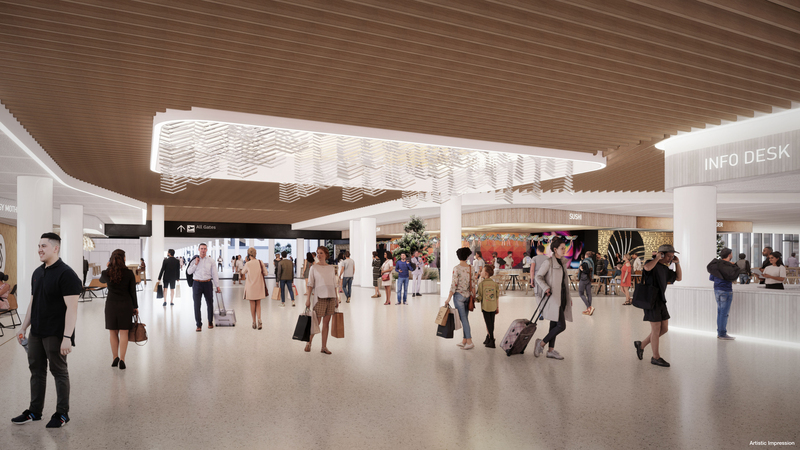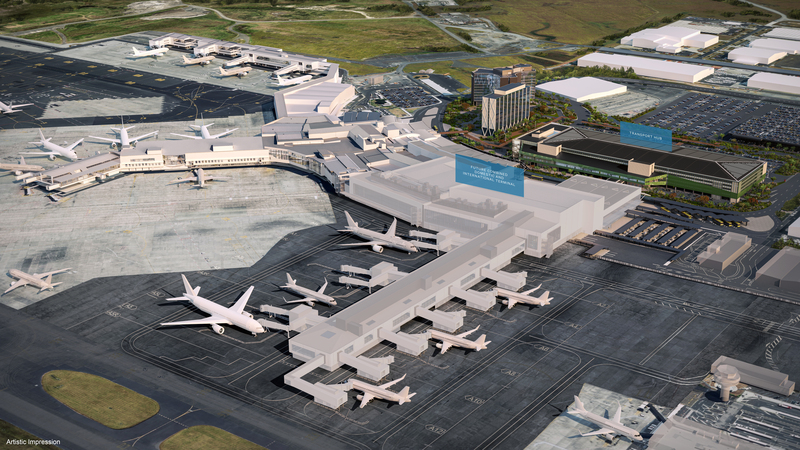NEW ZEALAND. Auckland Airport is set to begin a NZ$3.9 billion (US$2.4 billion) infrastructure upgrade to integrate a new domestic terminal with its international terminal. Set for completion between 2028 and 2029, the project is the biggest redevelopment since the airport opened in 1966.
The airport company said the modernisation plans include the replacement of the domestic terminal, at a cost of US$1.3 billion (NZ$2.2 billion).
The combined terminal is designed to serve larger and more efficient domestic jet aircraft flying to and from Auckland to New Zealand’s other main centres, as well as serving international operations. The work also incorporates ambitious low-carbon goals.

It will see 12 new domestic aircraft gates, +20% more than the current levels, with electric charging all catered for future aircraft.
The upgraded terminal is expected to enable faster transfer times, as well as larger retail and leisure spaces, modernised check-in area, and smart baggage system using -50% less power to process each bag than a conventional conveyor-based system.
Key elements of the upgrade also include a US$187.4 million (NZ$300 million) transport hub which is now under construction. The land adjoining the transport hub has been set aside for a future integrated mass transit station.

It will also feature an expanded floor space across two levels to the existing international terminal building, as well as major overhaul to the airfield pavement and underlying utilities, employing 2,000 people at the height of construction.

Auckland Airport’s Chair Patrick Strange said: “This is a major investment for Auckland Airport, one which we have been working towards for many years.”
“The domestic terminal is almost 60 years old and needs replacing. It’s nearing capacity and it’s no longer fit for purpose and hasn’t been for some time. If it wasn’t for the pandemic, we would already be well underway with its replacement.”
The airport operator said it has been consulting with its major airline customers since May 2011 on this terminal modernisation programme. Over that time, it had developed 21 concept designs and discussed with major airlines as part of the consultation process.
Strange said: “We have worked with major airlines for over a decade on this. We’ve considered all feedback, including potential alternative locations and even further delays to infrastructure development. All of this has been carefully thought through and we have made changes where appropriate, but now we need to get on with it.”
“A gateway to serve generations to come” – Auckland Airport’s vision for its next phase of growth
In line with its ambitious sustainability goals, the upgraded airfield surrounding the new combined terminal will provide charging for electric ground handling equipment and vehicles. Design and construction materials for the combined terminal will be selected to reduce the building’s carbon footprint as much as possible, alongside a focus on waste minimisation and water efficiency.
Strange said: “It will ensure New Zealand’s main gateway is resilient and sustainable, supporting airline ambitions for a low-carbon future and strengthening our infrastructure in the face of increasingly severe weather events due to climate change.”
Auckland Airport Chief Executive Carrie Hurihanganui also commented: “Sustainability is a priority for us – this investment will help us move towards climate change goals and create a more sustainable airport.”
“We have worked very closely with major airlines to understand their needs and requirements, including the investment they’re making in larger domestic aircraft, and their planned future low-carbon aircraft. We are supporting airlines by installing ground power units at each gate to supply power to aircraft, helping to reduce fuel use.”
Pre-pandemic, Auckland Airport served 62% of all domestic passengers in New Zealand annually, or a total of 9.6 million, while 11.5 million international passengers (including transits) passed through the international terminal.
Regional turbo prop flights, those travelling to smaller town centres, will remain in the existing domestic terminal for now. The airport is currently consulting with major airlines and the Board of Airline Representatives on the future location for regional travel.
The airport also noted that the terminal integration project is expected to straddle the next two pricing periods, together spanning 2023 to 2032, due to the scale of the project. Aeronautical price consultation for the 2028 to 2032 financial years will be completed by June 2027.











